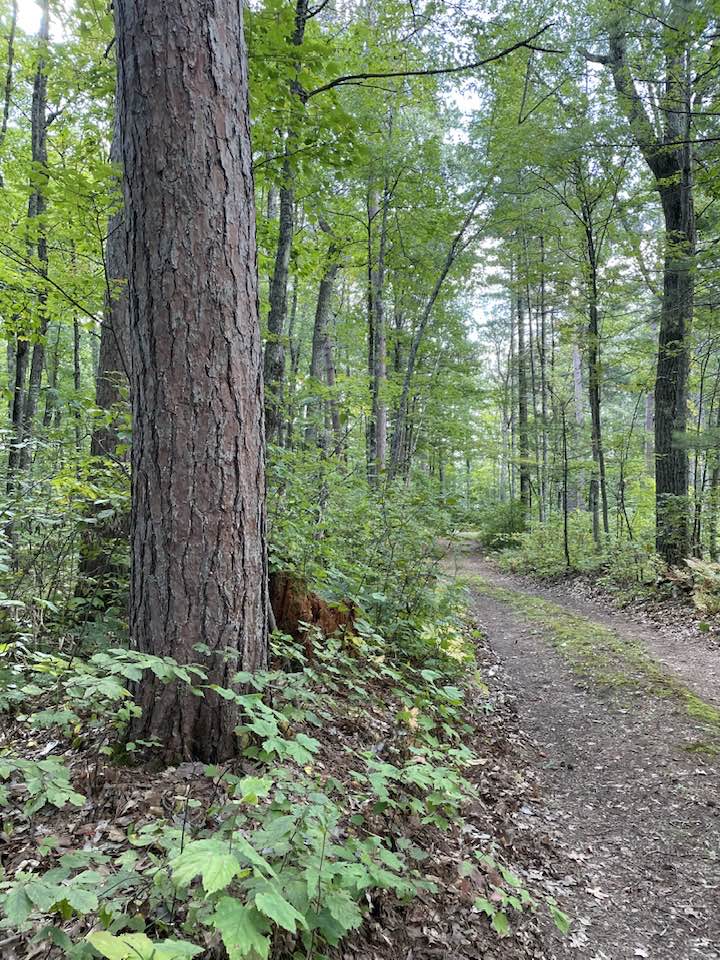SEPTEMBER 21, 2022 – Today at the lake, I took a long walk down the quarter-mile, two-tire track drive that leads from our old family cabin of Björnholm to Coppersmith Road, a winding, undulating dirt lane that provides access to the paved county road a mile from the cabin. I hadn’t walked this route in over a year. Under the circumstances, my hike out and back triggered many thoughts and memories.
I’ve traveled the route thousands of times. I’ve gotten to know every nuance, every change in elevation. Just beyond where our drive merges onto Coppersmith used to stand a long row of very old, tall poplars along each side of the road. Both rows leaned inward with upper branches integrating directly over the middle. This unusual positioning produced the effect of a long, cavernous Gothic cathedral, and each time I passed under those poplars, I felt I was in a special, spiritual place.
Today, most of the poplars are long gone, but enough remnants remain to suggest the ruins of an ancient cathedral. During this morning’s walk, I observed closely the surrounding woods and how they too have changed over the decades. Nothing in nature is static.
“Nature.” What is it exactly? So often we think of ourselves as apart from “nature”; as aliens, interlopers, manipulators, destroyers. Yet, I thought, we and our works are as much the evolutionary progeny of the earliest prokaryotic cells known as “LUCA”—Last Universal Common Ancestor—as are the flora and fauna of those woods; as is all of “nature.”
As I pondered the “nature” of the woods, and as I noticed the spectrum of “life” along my route, the parallels between the woods and humankind were unmistakable.
For the previous few days, I’d been contemplating the lack of broad, meaningful strategic policy in political discourse. Lots of “strategizing” occurs, but it’s almost entirely political; rarely do politicians—or their constituents—think or talk in broad, comprehensive strategic terms, wherein overlapping issues and systemic problems are analyzed and addressed from a visionary perspective. We’re much too mired in a reactive mode, often around the acute crisis of the day.
But what of “nature”? Does it have a strategic plan Of course not! Researchers have shown a highly integrated system of life in “nature”—underground fungal filaments serving as a kind of “internet” that allows various flora—trees in particular—to communicate with one another, and as crises arise, contributing to common defense against disease, infestations, and nutrient deprivation. Much can be learned from this “collective effort,” but as rigorous as it might be, it never develops into a “strategic plan.” The same applies to human affairs: we’re capable of complex organization and cooperative endeavors, but these features never morph into a unified strategy for improvement of our over-all prospects. Progress occurs but in fits and starts and never do advancements in our many strivings unfold in unison.
On full display in the woods is the full circle of life. New life thrives in the midst of death and decay—in fact, because of it—and yet, nothing in the woods is truly dead. Put all stages of decay under a microscope, and you’ll see microbes thriving; microbes essential to the breakdown of the fallen oak or pine are just as essential for the germination of an acorn and seed from a cone.
Are we humans not the same? New life and vigor succeed in the wake of lives bygone.
After making these comparisons between woods and humankind, I observed the equinoctial sun burst forth, casting its magical light through the trees. I approached a maple hanging over the road and was struck by the detail revealed in its translucent leaves. They hadn’t yet turned, but having lived through a long, hot summer, they were no longer fresh and free of imperfections, as they had been late in May. Soon they’d turn red and yellow, and shortly thereafter their plumage would succumb to autumnal winds, float to the ground, decay, and feed the very tree that had produced those very leaves.
This endless cycle of the seasons requires no strategic plan. It’s simply part of a grand, random scheme of the orientation of the earth’s axis combined with the earth’s revolution around the sun.
Without thinking about it, today I walked along and through our woods for a total of four miles and up and down the terrain created by the Ice Age, accumulated the equivalent of 80 flights of stairs (800 vertical feet)—five beyond my daily quota before the stem cell transplant.
From my walk in the woods I found new energy, new inspiration, and, I believe, insight into our place . . . in nature.
(Remember to subscribe to this blog and receive notifications of new posts by email.)
© 2022 by Eric Nilsson
